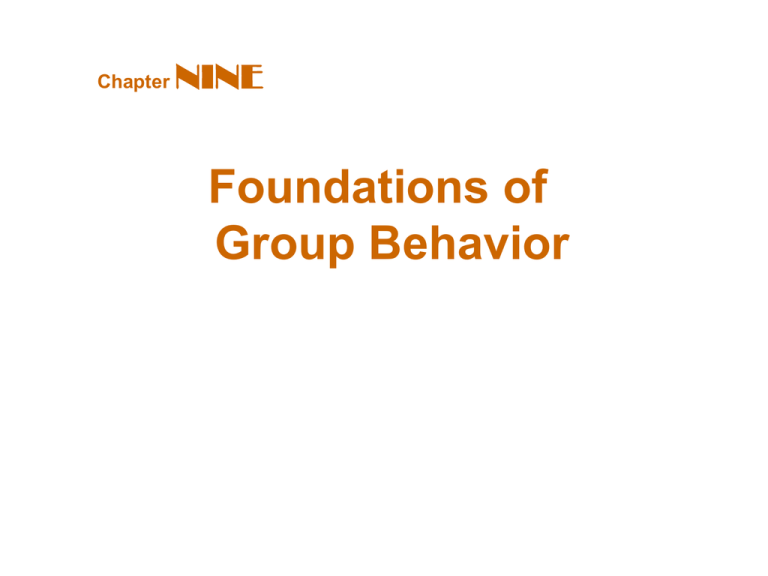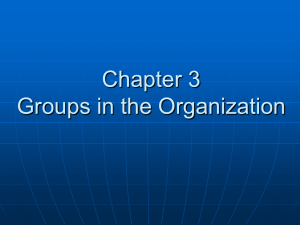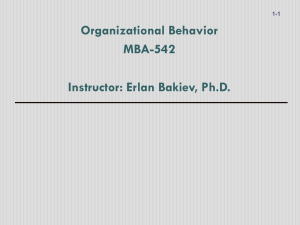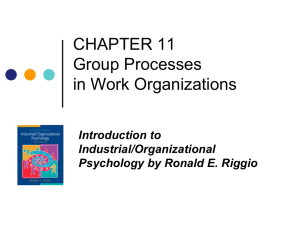
Chapter
NINE
Foundations of
Group Behavior
Defining and Classifying Groups
Group(s)
Two or more individuals interacting and
interdependent, who have come together
to achieve particular objectives.
Formal Group
Informal Group
A designated work
group defined by the
organization’s structure.
A group that is neither
formally structured nor
organizationally determined;
appears in response to the
need for social contact.
Defining and Classifying Groups (cont’d)
Command Group
Task Group
A group composed of
the individuals who
report directly to a
given manager.
Those working together
to complete a job or task.
Interest Group
Friendship Group
Those working together
to attain a specific
objective with which
each is concerned.
Those brought together
because they share one
or more common
characteristics.
Why People Join Groups
• Security
• Status
• Self-esteem
• Affiliation
• Power
• Goal Achievement
The Five-Stage Model of Group Development
Forming Stage
The first stage in group development, characterized
by much uncertainty.
Storming Stage
The second stage in group development,
characterized by intragroup conflict.
Norming Stage
The third stage in group
development, characterized
by close relationships and
cohesiveness.
…Group Development (cont’d)
Performing Stage
The fourth stage in group development, when the
group is fully functional.
Adjourning Stage
The final stage in group
development for temporary
groups, characterized by
concern with wrapping up
activities rather than
performance.
Stages of Group Development
E X H I B I T 9–2
An Alternative Model: Temporary Groups with
Deadlines
PunctuatedEquilibrium Model
Temporary groups
under time constrained
deadlines go through
transitions between
inertia and activity---at
the half-way point,
they experience an
increase in productivity.
Sequence of actions:
1. Setting group direction
2. First phase of inertia
3. Half-way point transition
4. Major changes
5. Second phase of inertia
6. Accelerated activity
The Punctuated-Equilibrium Model
E X H I B I T 9–3
Why are some group efforts more
successful than others?
Group Behavior Model (Determines group
performance
Group
Member
Resources
External
Conditions
Group
Task
Group
Processes
Group
Structure
Performance
and
Satisfaction
External Conditions
Imposed on the Group
Group is a subsystem of formal organisation and is
influenced by elements of the organisation. Such elements
are:
Overall organisation strategy
Culture
Authority structures
Work setting
Formal regulations
Employee selection
Organisation Resources
Evaluation-rewards
The Resources
of Group Members
Knowledge,
Skills, and
Abilities
Personality
Characteristics
Group structure
Organized systems and have structure that
shapes the behaviour of members. They include :
Formal leadership
Roles
Norms
Group status
Group size
Composition of the group
Degree of group cohesiveness
Formal Group Leadership
Supervisor
Project
Leader
Foreman
Task Force
Head
Department
Manager
Committee
Chair
Identity
Expectations
Group
Roles
Conflict
Perception
Group Properties - Roles
Role(s)
A set of expected behavior patterns attributed to
someone occupying a given position in a social unit.
Role Identity
Certain attitudes and behaviors
consistent with a role.
Role Perception
An individual’s view of how he or she
is supposed to act in a given situation.
Group Properties - Roles (cont’d)
Role Expectations
How others believe a person
should act in a given situation.
Psychological Contract
An unwritten agreement that sets
out what management expects from
the employee and vice versa.
Role Conflict
A situation in which an individual is confronted by
divergent role expectations.
Some roles played by group members
Task oriented roles
Relations oriented roles
Self oriented roles
Task oriented roles
Initiator-contributors
Information seekers
Opinion givers
Energisers (stimulates the group into
action)
Relations oriented roles
Harmonisers (mediate group conflict)
Compromisers
Encouragers
Expediters – suggest ways the groups can
operate more smoothly
Self oriented roles
Blockers – act stubborn and resistant to
the group
Recognition seekers
Dominators
Avoiders – isolate themselves
Performance
Appearance
Group
Norms
Resources
Arrangement
Group Properties—Norms
Norms
– Acceptable standards of behaviour within a group that
are shared by the group’s members
Classes of Norms
Performance norms – work groups advise members on
how hard they should work, level of output, time spent
etc
Appearance norms – dress, loyalty to group
Social arrangement norms-feature of an informal group
like whom to have lunch with, social games
Allocation of resources norms- e.g assignment of difficult
tasks, allocation of tools and equipment
Group Properties - Norms (cont’d)
Conformity
Adjusting one’s behavior to align
with the norms of the group.
ASCH
STUDY
Reference Groups
Important groups to which
individuals belong or hope
to belong and with whose
norms individuals are likely
to conform.
EXHIBIT 9–4
Conformity
There are group norms that press us
toward conformity. That is, we desire to be
one of the group and avoid being visibly
different.
Do you publicly state a perception that
differs from the preannounce position or
you give an answer that you believe is
incorrect in order to agree with other
group members.
Status in the Group
Equity
Norms
Culture
Group Properties - Status
Status: A socially defined position or rank given to groups
or group members by others.
Power over
Others
Ability to
Contribute
Personal
Characteristics
Norms &
Interaction
Group Member
Status
Other things influencing
or influenced by status
Status Inequity
National
Culture
Size of the Group
• Small groups
• Large groups
• Social loafing
• Individual effort
Group Properties - Size
Social Loafing
The tendency for individuals to expend less effort when
working collectively than when working individually.
Performance
Other conclusions:
• Odd number groups do
better than even.
• Groups of 5 to 7 perform
better overall than larger
or smaller groups.
Group Size
The Composition
of the Group
Diversity Demography
Cohorts
Diversity – in terms of personalities, experience,
educational qualifications, gender etc.
Group demography – the degree to which
members of a group share a common
demographic attribute such as age, sex,
educational level, length of service in
organisation and the impact of this attribute on
turnover.
Cohorts – individuals who as part of a group hold
a common attribute.
Group Properties - Cohesiveness
Cohesiveness
Degree to which group members are attracted to
each other and are motivated to stay in the group.
Increasing group cohesiveness:
1.
2.
3.
4.
5.
6.
7.
Make the group smaller.
Encourage agreement with group goals.
Increase time members spend together.
Increase group status and admission difficultly.
Stimulate competition with other groups.
Give rewards to the group, not individuals.
Physically isolate the group.
Cohesiveness-Productivity Relationship
Cohesiveness
Performance Norms
High
Low
High
High
Productivity
Moderate
Productivity
Low
Low
Productivity
Moderate to Low
Productivity
Group Processes
The processes that go on within a
work group –
communication patterns
Group decision processes
Leader behaviour
Power dynamics
Conflict interactions etc.
Synergy
An action of two or more substances
that results in an effect that is
different from the individual
summation of the substances.
Social facilitation effect
The tendency for performance to
improve or decline in response to the
presence of others.
People seem to perform better on a
task in the presence of others if that
task is very well learned but poorer if
it is not well learned.
Effects of group processes
Potential
Group
effectiveness
+
=
Process
gains
Actual
Group
effectiveness
-
Process
losses
Group Decision Making
Decision-making
– Large groups facilitate the pooling of information about
complex tasks.
– Smaller groups are better suited to coordinating and
facilitating the implementation of complex tasks.
– Simple, routine standardized tasks reduce the
requirement that group processes be effective in order
for the group to perform well.
Group Decision Making (cont’d)
Strengths
– More complete
information
– Increased diversity
of views
– Higher quality of
decisions (more
accuracy)
– Increased
acceptance of
solutions
Weaknesses
– More time
consuming (slower)
– Increased pressure
to conform
– Domination by one
or a few members
– Ambiguous
responsibility
Group Decision Making (cont’d)
Groupthink
Phenomenon in which the norm for consensus
overrides the realistic appraisal of alternative course
of action.
Groupshift
A change in decision risk between the group’s
decision and the individual decision that member
within the group would make; can be either toward
conservatism or greater risk.
Symptoms Of The Groupthink Phenomenon
Group members rationalize any resistance to the
assumptions they have made.
Members apply direct pressures on those who
express doubts about shared views or who
question the alternative favored by the majority.
Members who have doubts or differing points of
view keep silent about misgivings.
There appears to be an illusion of unanimity.
Group Decision-Making Techniques
Interacting Groups
Typical groups, in which the members interact with
each other face-to-face.
Nominal Group Technique
A group decision-making method in which individual
members meet face-to-face to pool their judgments
in a systematic but independent fashion.
Group Decision-Making Techniques
Brainstorming
An idea-generation process that specifically
encourages any and all alternatives, while
withholding any criticism of those alternatives.
Electronic Meeting
A meeting in which members
interact on computers, allowing
for anonymity of comments and
aggregation of votes.










